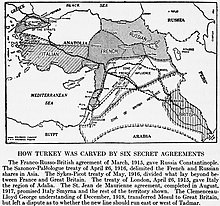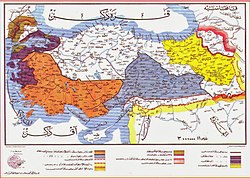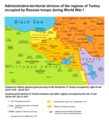This is the current revision of this page, as edited by Archives908 (talk | contribs) at 16:40, 20 December 2024 (Undid revision 1264077242 by Zhilbert (talk)). The present address (URL) is a permanent link to this version.
Revision as of 16:40, 20 December 2024 by Archives908 (talk | contribs) (Undid revision 1264077242 by Zhilbert (talk))(diff) ← Previous revision | Latest revision (diff) | Newer revision → (diff) Armenian historical region in Turkey "West Armenia" redirects here. For the football club, see FC West Armenia. For the Armenian dialect, see Western Armenian. For the government-in-exile, see Western Armenia Government in Exile.
| Part of a series on the |
|---|
| History of Armenia |
 |
| Prehistory |
| Antiquity |
| Middle Ages |
| Early modern age |
| Modern age |
| Timeline • Origins • Etymology |


Orange: areas overwhelmingly populated by Armenians (Republic of Armenia: 98% and Javakheti: 95%)
Yellow: Historically Armenian areas with presently no or insignificant Armenian population (Western Armenia, Nakhichevan and Nagorno-Karabakh)
Western Armenia (Western Armenian: Արեւմտեան Հայաստան, Arevmdian Hayasdan) is a term to refer to the western parts of the Armenian highlands located within Turkey (formerly the Ottoman Empire) that comprise the historical homeland of the Armenians. Western Armenia, also referred to as Byzantine Armenia, emerged following the division of Greater Armenia between the Byzantine Empire (Western Armenia) and Sassanid Persia (Eastern Armenia) in AD 387. Since the Armenian genocide, the Armenian diaspora as well as Armenians indigenous to modern Turkey have sought political representation in Western Armenia or reunification with the Republic of Armenia.
The area was conquered by the Ottomans in the 16th century during the Ottoman–Safavid War (1532–1555) against their Iranian Safavid arch-rivals. Being passed on from the former to the latter, Ottoman rule over the region became only decisive after the Ottoman–Safavid War of 1623–1639. The area then became known also as Turkish Armenia or Ottoman Armenia. During the 19th century, the Russian Empire conquered all of Eastern Armenia from Iran, and also some parts of Turkish Armenia, such as Kars. The region's Armenian population was affected during the widespread massacres of Armenians in the 1890s.
The Armenians living in their ancestral lands were exterminated or deported by Ottoman forces during the 1915 Armenian genocide and over the following years. The systematic destruction of Armenian cultural heritage, which had endured over 4000 years, is considered an example of cultural genocide.
Since 2000, an organizing committee of the congress of heirs of Western Armenians who survived the Armenian genocide is active in diasporan communities. On August 10, 2020, the three traditional Armenian parties—the Armenian Revolutionary Federation (ARF, Dashnaks), Social Democrat Hunchakian Party (Hunchaks) and the Armenian Democratic Liberal Party (Ramgavars)—issued a joint statement on the centenary of the Sèvres Treaty, stating that the treaty is the only international document defining the border between Armenia and Turkey. "The Treaty of Sevres is a valid international treaty, although it has not been ratified by all signatories, but it has not been legally replaced by any other international instrument. At least from the point of view of the rights of the Armenian Cause, the Republic of Armenia and the Armenian nation, it remains a promissory note based on international law."
Etymology

In the Armenian language, there are several names for the region. Today, the most common is Arevmtyan Hayastan (Արևմտյան Հայաստան) in Eastern Armenian (mostly spoken in Armenia, Russia, Georgia, Iran) and Arevmdean Hayasdan (Արեւմտեան Հայաստան) in Western Armenian (spoken in the Diaspora: US, France, Lebanon, Syria, Argentina, etc.). Archaic names (used before the 1920s) include Tačkahayastan (Տաճկահայաստան) in Eastern and Daǰkahayasdan in Western Armenian. Also used in the same period were T'urk'ahayastan (Թուրքահայաստան) or T'rk'ahayastan (Թրքահայաստան), both meaning Turkish Armenia.
In the Turkish language, the literal translation of Western Armenia is Batı Ermenistan. The region has been officially described as Eastern Anatolia (Doğu Anadolu) since the seven geographical regions of Turkey were defined at the 1941 First Geography Congress. Throughout much of recorded history the eastern boundary of Anatolia was not considered to extend as far as the Araxes, the river which marks the present day boundary between the states of Armenia and Iran.
History
Ottoman conquest
After the Ottoman-Persian War (1623–1639), Western Armenia became decisively part of the Ottoman Empire. After the Russo-Turkish War, 1828–1829, the term "Western Armenia" referred to the Armenian-populated historical regions of the Ottoman Empire that remained under Ottoman rule after the eastern part of Armenia was ceded to the Russian Empire by the Qajar Persians, following the Russo-Persian War (1804–1813) and Russo-Persian War (1826–1828).
Western (Ottoman) Armenia consisted of six vilayets (vilâyat-ı sitte): the vilayets of Erzurum, Van, Bitlis, Diyarbekir, Kharput, and Sivas.
The fate of Western Armenia – commonly referred to as "The Armenian Question" – is considered a key issue in the modern history of the Armenian people.
World War I and later years

Armenian genocide
Main article: Armenian genocideIn 1894–1896 and 1915 the Ottoman Empire perpetrated systematic massacres and forced deportations of Armenians resulting in the Armenian genocide. The massive deportation and killings of Armenians began in the spring 1915. On 24 April 1915, Armenian intellectuals and community leaders were deported from Constantinople. Depending on the sources cited, about 1,500,000 Armenians were killed during this act.
Caucasus campaign
Main articles: Caucasus campaign and Occupation of Turkish ArmeniaDuring the Caucasus campaign of World War I, the Russian Empire occupied most of the Armenian-populated regions of the Ottoman Empire. A temporary provincial government was established in occupied areas between 1915 and 1918.
The chaos caused by the Russian Revolution of 1917 put a stop to all Russian military operations and Russian forces began to conduct withdrawals. The first and second congresses of Western Armenians took place in Yerevan in 1917 and 1919.
Sazonov–Paléologue Agreement
The Sazonov–Paléologue Agreement of 26 April 1916 between Russian Foreign minister Sergey Sazonov and French ambassador to Russia Maurice Paléologue proposed to give Western Armenia to Russia in return for Russian assent to the Sykes–Picot agreement.
Current situation

Currently, Armenia does not have any territorial claims against Turkey, although one political party, the Armenian Revolutionary Federation, the largest Armenian party in the diaspora, claims the area given to the Republic of Armenia (1918–1920) by US President Woodrow Wilson's arbitral award as part of the Treaty of Sèvres in 1920, also known as Wilsonian Armenia.
Since 2000, an organizing committee of the congress of heirs of Western Armenians who survived the Armenian genocide is active in diasporan communities.
A 2014 survey in Armenia asked what kind of demands should Armenia make to Turkey. Some 80% agreed that Armenia should make territorial claims (30% said only territorial claims, while another 50% said territorial, moral, financial, and proprietary). Only 5.5% said no demands should be made. According to a 2012 survey, 36% of Armenians asked agree or somewhat agree that Turkish recognition of the Armenian Genocide will result in territorial compensation, while 45% believe it will not. The online publication Barometer.am wrote: "It appears that our pragmatic population believes that all possible demands should be forwarded to Turkey but a relative majority consider the practical realization of territorial claims to Turkey is unrealistic."
Territories claimed

| Area | Part of | Area (km) | Population | Armenians | % Armenian | Source |
|---|---|---|---|---|---|---|
| Western Armenia | 132,967 | 6,461,400 | 70.000 | 0.09 | 2009 estimate |
Gallery
-

-
 Western Armenia the first half of the 18th century. Herman Moll's map,1736.
Western Armenia the first half of the 18th century. Herman Moll's map,1736.
-
 Armenia Turkomania on 1810 map.
Armenia Turkomania on 1810 map.
-
 Persis, Parthia, Armenia. Rest Fenner, published in 1835.
Persis, Parthia, Armenia. Rest Fenner, published in 1835.
-
 The Six Armenian vilayets (provinces) of the Ottoman Empire were defined as Western Armenia.
The Six Armenian vilayets (provinces) of the Ottoman Empire were defined as Western Armenia.
-
 Autonomous Armenian province within the Ottoman Empire, proposed by the Russian Empire, the Armenian National Assembly and the Armenian Catholicosate in 1913.
Autonomous Armenian province within the Ottoman Empire, proposed by the Russian Empire, the Armenian National Assembly and the Armenian Catholicosate in 1913.
-
 Armenian reform package in Ottoman Empire, finally signed by representatives of the Ottoman Empire and the Russian Empire on February 8, 1914, and providing for the creation of 2 provinces under the control of inspectors general appointed by the Great Powers.
Armenian reform package in Ottoman Empire, finally signed by representatives of the Ottoman Empire and the Russian Empire on February 8, 1914, and providing for the creation of 2 provinces under the control of inspectors general appointed by the Great Powers.
-
 Armenian genocide: map of massacre locations and deportation and extermination centers.
Armenian genocide: map of massacre locations and deportation and extermination centers.
-
 The area of Russian occupation of Western Armenia in summer 1916 (Russian map).
The area of Russian occupation of Western Armenia in summer 1916 (Russian map).
-
 The area of Russian occupation of that region in summer 1916.
The area of Russian occupation of that region in summer 1916.
-
 Administrative-territorial division of Western Armenia, occupied by Russian troops in 1915-1917 .
Administrative-territorial division of Western Armenia, occupied by Russian troops in 1915-1917 .
-
 USSR (Armenian SSR and Georgian SSR) territorial claims against Turkey 1945–1953.
USSR (Armenian SSR and Georgian SSR) territorial claims against Turkey 1945–1953.
-
 The modern concept of United Armenia as used by Woodrow Wilson and the Armenian Revolutionary Federation (Dashnaktsutyun).
The modern concept of United Armenia as used by Woodrow Wilson and the Armenian Revolutionary Federation (Dashnaktsutyun).
-
 Early 1600s spread of Armenians, a few decades after Ottoman conquest, within modern Turkey, per the State Committee of the Real Estate Cadastre of Armenia
Early 1600s spread of Armenians, a few decades after Ottoman conquest, within modern Turkey, per the State Committee of the Real Estate Cadastre of Armenia
See also
- History of Armenia
- Geography of Armenia
- Armenian Highlands
- Armenians in the Ottoman Empire
- Ottoman Armenian population
- Hidden Armenians
- Treaty of Lausanne
- Armenia without Armenians
- Turkish Kurdistan
- Provinces of the kingdom of Armenia (antiquity)
Notes
- "The lands of Western Armenia which Mt. Ararat represent..." "mount Ararat is the symbol of banal irredentism for the territories of Western Armenia""...Ararat, which is in the territory of modern Turkey but symbolizes the dream of all Armenians around the globe about the lands lost to the west of this biblical mountain."
References
- "2011 Census Results" (PDF). armstat.am. National Statistical Service of Republic of Armenia. p. 144.
- Myhill, John (2006). Language, Religion and National Identity in Europe and the Middle East: A historical study. Amsterdam: J. Benjamins. p. 32. ISBN 978-90-272-9351-0.
- "About Government" Archived 2023-04-15 at the Wayback Machine. The Government of the Republic of Western Armenia (Armenia).
- "Western Armenians are preparing". A1+. 16 November 2007. Archived from the original on 27 September 2008.
- ^ Wallimann, Isidor; Dobkowski, Michael N. (March 2000). Genocide and the Modern Age: Etiology and Case Studies of Mass Death. Syracuse University Press. ISBN 9780815628286. Retrieved 30 December 2014.
- Tozer, Henry Fanshawe (1881). Turkish Armenia and Eastern Asia Minor. Longmans, Green, and Company. ISBN 9780404164621.
- Laderman, Charlie (2019). Sharing the Burden: The Armenian Question, Humanitarian Intervention, and Anglo-American Visions of Global Order. Oxford University Press. p. 42. ISBN 9780190618605.
- Timothy C. Dowling Russia at War: From the Mongol Conquest to Afghanistan, Chechnya, and Beyond pp 728–729 ABC-CLIO, 2 December 2014 ISBN 1598849484
- Marie-Aude Baronian; Stephan Besser; Yolande Jansen (2007). Diaspora and Memory: Figures of Displacement in Contemporary Literature, Arts and Politics. Rodopi. p. 174. ISBN 9789042021297.
- Shirinian, Lorne (1992). The Republic of Armenia and the rethinking of the North-American Diaspora in literature. Lewiston, New York: Edwin Mellen Press. p. ix. ISBN 9780773496132.
This date is important, for it marks the beginning of the Armenian Genocide, which destroyed the multi-thousand-year Armenian presence in historical, Western Armenia.
- Hovannisian, Richard G. (2008). The Armenian Genocide: Cultural and Ethical Legacies. New Brunswick, New Jersey: Transaction Publishers. p. 22. ISBN 9781412835923.
- Jones, Adam (2013). Genocide: A Comprehensive Introduction. Routledge. p. 114. ISBN 9781134259816.
- ^ "Western Armenians are preparing". A1+. 16 November 2007. Archived from the original on 27 September 2008.
- "Սեւրի Դաշնագրի 100-ամեակին առիթով Ս.Դ.Հ.Կ.-Հ.Յ.Դ.-Ռ.Ա.Կ. միացեալ յայտարարութիւն – Հայ Դատի Կենտրոնական Խորհուրդ — Armenian National Committee – International". 13 January 2021. Archived from the original on 13 January 2021. Retrieved 29 July 2022.
- Shirinian, Lorne (1992). The Republic of Armenia and the rethinking of the North-American Diaspora in literature. Lewiston, New York: Edwin Mellen Press. p. 78. ISBN 978-0773496132.
- Adriaans, Rik (2011). "Sonorous Borders: National Cosmology & the Mediation of Collective Memory in Armenian Ethnopop Music". University of Amsterdam. p. 48. Archived from the original on 5 March 2016.
- Khojoyan, Sara (1 August 2008). "Beyond and Inside: Turk look on Ararat with Armenian perception". ArmeniaNow.
- "The Terrain of "Living" Western Armenian Literature".
- Hacikyan, Agop Jack (2005). The Heritage of Armenian Literature: From the eighteenth century to modern times. Wayne State University Press. ISBN 0814332218.
- Dowling, Timothy C. (2014). Russia at War: From the Mongol Conquest to Afghanistan, Chechnya, and Beyond. ABC-CLIO. pp. 728–729. ISBN 978-1598849486.
- "Armenia". worldstatesmen.org.
- Kirakossian, Arman J. (2004). British Diplomacy and the Armenian Question, from the 1830s to 1914. Taderon.
- Armenia at the Encyclopædia Britannica
- "The Lasting Legacy of the Second Congress of Western Armenians".
- Spencer Tucker (2005). World War I: Encyclopedia. ABC-CLIO. pp. 1142–. ISBN 978-1-85109-420-2.
- The Armenian Review. Hairenik Association. 1956.
The Sazonov-Paleologue agreement of 26 April 1916 between Great Britain and France and the Sykes–Picot agreement of 16 May 1916 between Great Britain and France which together made up the Anglo-Franco-Russian accord of 1916...
- Government of Western Armenia
- Decree on the flag of Western Armenia
- ^ "Ի՞նչ ենք ուզում Թուրքիայից - Real Politics - Barometer". 4 March 2016. Archived from the original on 4 March 2016. Retrieved 29 July 2022.
- "Caucasus Barometer 2012 Armenia | Armenia will receive territorial compensation, if Turkey recognizes the Genocide | Online Data Analysis". 11 June 2014. Archived from the original on 11 June 2014. Retrieved 29 July 2022.
- "Armenians of Istanbul - Istanbul Armenians". www.bolsohays.com. Retrieved 21 January 2021.
- Papian 2009, p. 37. sfn error: no target: CITEREFPapian2009 (help)
- State Committee of the Real Estate Cadastre of the Republic of Armenia (2007). Հայաստանի Ազգային Ատլաս (National Atlas of Armenia), Yerevan: Center of Geodesy and Cartography SNPO, p. 102 see map
Further reading
- Arman J. Kirakosian, "English Policy towards Western Armenia and Public Opinion in Great Britain (1890–1900)", Yerevan, 1981, 26 p. (in Armenian and Russian).
- Armen Ayvazyan, "Western Armenia vs Eastern Anatolia", Europe & Orient – n°4, 2007
External links
- Video: Provinces of Western Armenia
- Radio Television Western Armenia
- The Centennial of the Armenian Genocide
| Armenian genocide | |||
|---|---|---|---|
| Background | |||
| Genocide |
| ||
| Demography | |||
| Resistance | |||
| Perpetrators | |||
| International response | |||
| Prosecution | |||
| Cultural depictions |
| ||
| Aftermath | |||
| Related | |||
| Irredentism | |
|---|---|
| Africa | |
| North America | |
| South America | |
| Western Asia | |
| Southern Asia | |
| Eastern and Southeastern Asia | |
| Central and Eastern Europe | |
| Southern Europe | |
| Italy | |
| Northern Europe | |
| Western Europe | |
| Oceania | |
| Related concepts: Border changes since 1914 · Partitionism · Reunification · Revanchism · Revisionism · Rump state | |